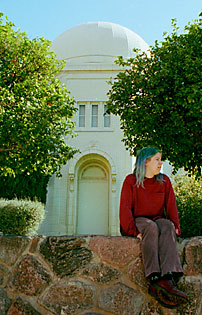 |
|
ALYSON E. GROVE/ Arizona Daily Wildcat
|
Astronomy and physics senior Brooke White stands in the Steward Observatory courtyard last week discussing a new type of star she and other students discovered in 2000 using UA's telescopes.
|
|
By Joshua Sills
Arizona Daily Wildcat
Tuesday February 25, 2003
A group of UA astronomy undergraduates found something out of this world more than two years ago.
Now, astronomers all over earth who specialize in a new field called "asteroseismology, " will have the opportunity to observe the students' findings.
Through telescopes usually reserved for researchers and graduates, the five students accidentally discovered a new class of star.
Astronomers from Canada, Germany, South Africa, Australia, Spain and South America will collaborate in continuous observations of one of these newly discovered stars for several weeks in May, said Elizabeth Green, assistant staff astronomer at Steward Observatory.
 |
|
It is important because the stars have little or no atmosphere, making them easier to study.
- Elizabeth Green
assistant staff astronomer
Steward Observatory
|
 |
Melissa Giovanni was working for Green in 1999 when she became the first to discover a difference in the light pattern that led to the discovery of the new type of star.
The class of stars, Sub-dwarf B stars, are extremely hot, pulsate like Jell-O and quiver in space through one-hour cycles, according to the Department of Astronomy Web site.
"It is important because the stars have little or no atmosphere, making them easier to study," Green said.
Green and the undergraduates reported finding seven stars in three to five modes, or patterns of wave motion or vibration, and maybe as many as 10 or more modes.
By now, the group has discovered 23 stars in the 100 they have examined, 18 of which were found last year.
Ivo Seitenzahl and Keith Callerame worked with Green and Giovanni during the summer of 2000.
At the time, students worked in pairs on the weekends, mostly at the 61-inch Kuiper Telescope on Mount Bigelow, and sometimes with a 90-inch telescope on Kitt Peak.
"We were very lucky to be trained on those telescopes. Ivo and I sort of started a pilot program," Callerame said.
Giovanni was one of the first undergraduates to ever be allowed to observe the night sky through a larger telescope alone.
"During the monsoon there wasn't much opportunity to observe, but Melissa stuck with it and found the different light pattern," Green said.
"We had a couple suspect stars and one turned out to be a Sub-dwarf B," Giovanni said.
The group observed more stars and found more possibilities.
Since then Giovanni, Callerame and Seitenzahl have all graduated from the UA. All three are pursuing graduate degrees.
But others have since joined the effort to observe and study the new stars.
Current UA undergraduates, Brook White, astronomy and physics senior and Elaina Hyde, an astronomy, physics and optical engineer, are also involved in the observation program that began with Giovanni in 1999.
White began her junior year observing possible Sub-dwarf B stars.
"Elizabeth trained Elaina and I to use 91 inch telescope. I felt really lucky. I thought it was really unusual to be able to use these telescopes at first but then realized that there is opportunities like this for undergrads at Arizona," White said.
The National Science Foundation provides all grants for the program.
"The NSF likes to give money for projects like this. It's a splendid educational opportunity," Green said.
More students from other states and countries are expected to join the research process in the near future.
"I think I got really lucky to be a part of it," Hyde said.

